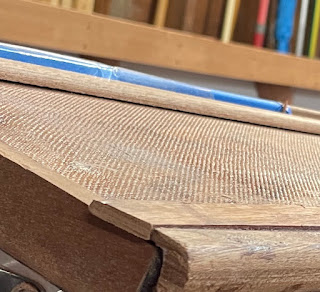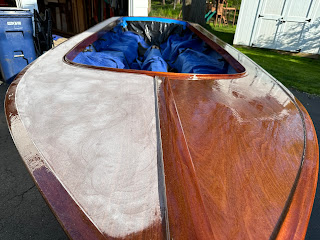Varnishing the Deck
When I left off last season, I had put the fiberglass on the deck but ran out of warm weather before I could put on the epoxy filler coats to hide and protect the weave in the fiberglass cloth and leave a nice smooth surface for varnishing.
Fiberglass normally takes two or three coats of epoxy and some sanding to get a smooth glass-like finish. I started with a sealer coat before installing the fiberglass cloth so the wood doesn’t absorb all the epoxy, followed by a coat to wet out the fiberglass cloth and bind it to the wood. The weave of the glass cloth is still visible after wetting it out as shown above, so one or two epoxy filler coats is required to make it smooth. I wet out the glass in the fall and did the filler coats in the spring. Using a foam roller, one coat mostly filled the weave. I then touched up any low spots with a chip brush. Photo below is the deck after rolling on the filler coat, before sanding.
It’s always tough to take a sander to the fresh and shiny epoxy, which turns it a milky white, but sanding removes any drips, runs, or brush marks and exposes any low spots (they remain shiny). The fiberglass needs to be varnished after sanding to protect it from UV, which will bring back the gloss. The picture below shows the contrast - the starboard side of the deck is sanded and the port side hasn’t been yet.
After three passes of sanding the deck working my way down to 180 grit it is almost ready for varnish. I just have to install all of the deck fittings (cleats, blocks, chain plates, etc.) and sand the trim. The sanding was very time consuming and not much fun, but the varnish will amplify any flaws so hopefully it is worth it.
After one more pass at sanding with 220 grit, I gave the entire boat a good rinse to get the dust off. This was the first time I really got the boat wet - I used a hose to rinse the interior and exterior - which brought up a lot of saw dust. I had to lift the bow quite a bit to drain the water out of the boat. I put a floor jack under the trailer jack to do this. It was pretty precarious and probably not the smartest thing I’ve done but as they say, it’s not stupid if it works.
The water really brought out the shine in the wood surfaces (the sanding made everything dull and chalky) and gave a preview of what it will look like after I varnish everything.
I am so glad to be done sanding. The main remaining task is to apply the varnish. I wound up using three different brands of varnish.
I used the Epifanes for the mast and boom. A liter was just enough for six coats on the boom and mast. I chose Epifanes because it is a classic spar varnish that remains flexible when it cures. It is kind of a pain to apply because you need to wait a full day and scuff everything with steel wool between coats.
The Bristol Finish is a premium (i.e. expensive) two part varnish that is supposed to be easy to apply and very durable, so I splurged and bought enough (I hope) for the deck, rub rail, and coaming.
Finally, the TotalBoat Gleam 2.0 is for the interior including the seats, floorboard and frames. It is a one part varnish like Epifanes but you apply multiple coats in a day an hour apart without sanding. It also is supposed to be easy to apply and is much more affordable than the others when bought in gallon size.
To keep dust down, I gave the garage a thorough and long overdue cleaning, including using a leaf blower to blow out the saw dust that covered pretty much everything. I then stapled some disposable 0.7 mil plastic drop cloths to the garage rafters and walls. I also wore pair of tyvek painters coveralls while applying the varnish. As I learned later, all this prep makes a big difference
The instructions for the Bristol varnish say six coats are required over bare wood or old varnish, but don’t say how many are required over fiberglass / epoxy. I bought a quart of varnish, which is actually 36 ounces because it is a two part varnish and comes with 4 ounces of hardener (you add 1 ounce of hardener to each 8 ounces of varnish). This gives me 6 ounces per coat to get 6 coats. Six ounces was barely enough to cover the deck, rub rails, and coaming so I decided to only do 5 coats to leave a little extra for the last coat so I don’t wind up with any bare spots (or holidays as painters call them).
I applied the varnish with a 3” foam brush. I used the “practical method” of putting all but the last coat on hot (i.e. without sanding between them) in one day. This built up some thickness but left a lot of visible brush marks when it dried - not quite that poured-on glass-like appearance I was trying for. I think the problem was that six ounces wasn’t really enough to cover the entire deck, so I tried to apply it thin to avoid running out and wound up dragging the varnish and leaving brush marks. The varnish was also so glossy that it was hard to tell which parts were wet and which were dry when recoating.
After the first four coats dried, I sanded the whole deck before applying the last coat. It took a lot of sanding to fix all the brush marks so I was a little worried I sanded too much off. After sanding, which I stupidly did in the garage, I blew most of the dust off the boat and out of the garage with my leaf blower (big mistake) and wiped the hull down with thinner to get rid of the sanding dust. I then mixed up the last batch of varnish, which was supposed to be bigger than the previous batches, but I wound up with less because I didn’t have enough catalyst to mix into the two part varnish. I thought this might be okay because the last coat only needed to cover the sanding marks and bring back the gloss, so it could be applied very thin. Unfortunately I was rushing to finish that night and didn’t wait long enough so all the dust I blew out earlier was still in the air and wound up being very visible in the last coat which looked very crappy.
I decided to buy another quart of Bristol varnish to try to fix it. Normally I’d order it online since it is kind of a specialty product and isn’t available anywhere locally. I needed to get it asap because my wife was out of town and I wanted to finish before she got home since the fumes really bother her. I convinced myself the best option was to drive 3 hours to the nearest place I could find that carried it, Noah’s Marine in Toronto, who luckily had one can left that they held for me. I took an afternoon off work and left at 1pm, crossed into Canada, drove to Noah’s, crossed back into the US, and got home about 8:30 pm and decided to do the final coat that night to maximize the time the fumes had to dissipate before my wife got home.
I took extra care to do things by the book this time to keep the dust down. I brought the boat outside and closed the garage before sanding. I then blew the dust off and wiped everything down with thinner outside. I brought the boat back inside the garage and wiped it down with another coat of thinner followed by a tack cloth. I then sprayed the floor with water so I wouldn’t kick up any dust when I walked, and changed out of the clothes I used to sand and into a tivek bunny suit.
I mixed 9 ounces of varnish and carefully applied it with a foam brush taking great care to use good technique, keep my brush wet, keep a wet edge, and avoid going back. I also wore a head lamp to help me see any spots I missed. Since I had just sanded, it was obvious what was wet and what was just sanded which made it a lot easier. Having enough varnish mixed made a huge difference - the thicker (but still not too thick) coat really flowed out and self-leveled nicely. All the prep and care, as well as the trip, was worth it because I finally got the poured on glass like finish I was trying for. There is still some dust, which I think is unavoidable unless you have a painting booth, but it is barely noticeable.
This is the deck and trim with the final coat of Bristol High-gloss two-part varnish applied. If I’m being super critical, the deck is a little wavy. I think this is from using a 5”’random orbital sander because it is hard to keep it level and avoid going back over some spots multiple times. I think I’d have to hand sand with a long board to avoid this?











Comments
Post a Comment